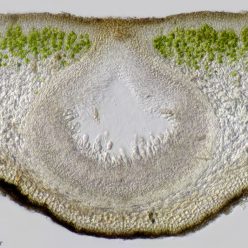- Robyn Roth, Ralf Wagner, Ursula Goodenough,
Lichen 3. Outer layers,
Algal Research,
Volume 56,
2021,
102332,
ISSN 2211-9264,
https://doi.org/10.1016/j.algal.2021.102332
(https://www.sciencedirect.com/science/article/pii/S221192642100151X)
Abstract: A lichen is a slow-growing niche-constructing organism that forms a thallus via scripted symbiotic/mutualist relationships between fungi, algae, and bacteria. Here we use quick-freeze deep-etch electron microscopy (QFDEEM), in conjunction with light microscopy, to document the structural manifestations of hyphal differentiation during the formation of three lichen tissues that localize between the algal layer and the surface of the thallus: the outer cortex of foliose lobes; the outer layer of fruticose stems; and the enwrapping layer of asexual propagules called soredia that protrude from squamulose podetia and foliose lobes. Our observations document features of outer-layer architecture and the role played by extracellular matrices (ECM). They also lead us to propose the medullary stem-cell hypothesis for lichen organization wherein totipotent medullary hyphae produce lateral branches that undergo specific differentiation pathways in specific domains of the thallus.
Keywords: Lichen; Ascomycete; Alga; Hyphal branching; Fungal extracellular matrix (ECM); Medullary stem-cell; Quick-freeze deep-etch electron microscopy
PDF Datei auf Anfrage
- Ursula Goodenough, Ralf Wagner, Robyn Roth,
Lichen 4. The Algal Layer,
Algal Research,
Volume 58,
2021,
102355,
ISSN 2211-9264,
https://doi.org/10.1016/j.algal.2021.102355.
(https://www.sciencedirect.com/science/article/pii/S2211926421001740)
Abstract: A lichen is a slow-growing niche-constructing organism that forms a thallus via scripted symbiotic/mutualist relationships between fungi, algae, and bacteria. Here we use quick-freeze deep-etch electron microscopy (QFDEEM) and light microscopy to probe a hallmark lichen construction wherein clusters of algae and hyphae, inter-connected by wall-to-wall junctions, form stable consortia that we call green modules. These assemble in the pseudo-meristem and then localize to the algal layer of the thallus. In the foliose lobes of Candelaria concolor, the cells in each module are enveloped in a continuous 10-nm-thick film of hydrophobin proteins, which binds to wall and matrix surfaces on its hydrophilic side and faces air or water on its hydrophobic side. We document patterned relationships between modules and associated cords of hyphae destined for the outer layers, and propose ways that these relationships could form the structural foundation for water and air regulation within foliose lobes.
Keywords: Lichen; Ascomycete; Alga; Green module; Hydrophobin; Fungal secondary products; Quick-freeze deep-etch electron microscopy
PDF Datei auf Anfrage
- Satoko Arakawa, Toku Kanaseki, Ralf Wagner, Ursula Goodenough,
Ultrastructure of the foliose lichen Myelochroa leucotyliza and its solo fungal and algal (Trebouxia sp.) partners,
Algal Research,
Volume 62,
2022,
102571,
ISSN 2211-9264,
https://doi.org/10.1016/j.algal.2021.102571.
(https://www.sciencedirect.com/science/article/pii/S2211926421003908)
Abstract: Lichens are slow-growing niche-constructing organisms formed via scripted symbiotic/mutualist relationships between fungi, algae, and bacteria. We have used quick-freeze deep-etch electron microscopy (QFDEEM), coupled with several additional microscopic techniques, to analyze the Japanese foliose lichen Myelochroa leucotyliza. We have also examined its constituent fungi and algae grown separately (solo) and in co-culture in the laboratory, as well as solo fungi incubated with conditioned algal media (CM) for 9 days. We report our general findings on M. leucotyliza architecture in a Supplement, and focus this report on three findings of particular interest. 1) Plasma membrane differentiations called nubbins are found adjacent to, and at the center of, the cell-wall septa in both lichenized and solo hyphae, suggesting a role in cell polarity determination and/or cell-cell communication within the hyphae. 2) Nubbins also localize to the tips of hyphal sub-branches produced by the lichenized but not the solo fungi. These in turn form tip-to-tip contacts (bridges) with one another, suggesting a role in inter-hyphal communication. 3) CM treatment of solo fungi induces a) the production of secondary metabolites, polysaccharides, and lipids; b) a transformation of ER topology and its association with the plasma membrane; and c) a dramatic change in vacuole organization, indicating that the algal growth medium contains soluble materials that trigger fungal differentiation.
Keywords: Lichen; Nubbin; Cell-wall septum; Endoplasmic reticulum; Vacuole; Hydrophobin
PDF Datei auf Anfrage
